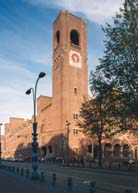The site of the events was the historic Beurs van Berlage, Amsterdam, Damrak 243, the former Amsterdam Stock Exchange.
The ERCIM 10th anniversary events took place in Amsterdam,
4-5 November 1999. This page is maintained for historical reasons.
Symposium: ERCIM - leveraging World Class R&D for Business and Society
|
|
 |
Gerard van Oortmerssen, President of ERCIM: 'ERCIM - The Challenge of the Next Century' Gerard van Oortmerssen started his studies in Maritime Technology at the Technical University of Delft. After completing his masters thesis, he began his working career as a researcher at the Maritime Research Institute (MARIN), where he was later appointed Head of Research and Development. In 1976 he completed his PhD thesis at the University of Delft on computer simulations in hydrodynamics. As a researcher he (co-) authored 45 scientific publications. In 1991, he moved from MARIN to CWI as Managing Director. In 1994 he was appointed General Director of CWI. In 1998 he was appointed President of ERCIM. He is advisor for several start-up companies in the ICT field. |
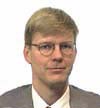 |
Heikki Hämmäinen, Vice President Nokia Networks: 'Towards the Mobile Information Society' Heikki Hämmäinen gained his Master of Science degree in Computer Science in 1984 from the Helsinki University of Technology and PhD from the same university in 1991. He started his industrial career in 1991 at the Nokia Research Center as Group manager for advanced communication applications. In 1994 he became Head of the Laboratory for Communication Systems of Nokia. His current position is Vice President of Nokia Networks, responsible for Systems Development within the Network Systems Division of Nokia. |
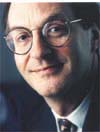 |
Alexander Rinnooy Kan, BoD ING Bank: 'Technology and its Impact on the Financial Services Industry' Alexander Rinnooy Kan started his career in mathematics and was a full professor of operations research at the University of Rotterdam in the early eighties. He then moved on to the directorship of the Econometric Institute and subsequently became Rector of the Erasmus University of Rotterdam. In 1991 he joined the national employers association VNO-NCW as chairman. Since 1996 he is a member of the Executive Board of the ING Group and heads the Executive Committee, responsible for ING's asset management. |
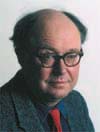 |
Roger Needham, Director of Microsoft Research Europe: 'Microsoft Research - What and Why' Roger Needham has been in computing at Cambridge since 1956 where he graduated in 1961. In 1962 he joined the Computer Laboratory, then called the Mathematical Laboratory, and has been on the faculty since 1963. He took a leading role in Cambridge projects. He has also worked at intervals on a variety of topics in security, (his main current research interest) being particularly known for work with Schroeder on authentication protocols (1978) and with Burrows and Abadi on formalism for reasoning about them (1989). He was Head of the Computer Laboratory from 1980 to 1995, was made Professor in 1981, elected to the Royal Society in 1985, and to the Royal Academy of Engineering in 1993. He is a member of the Technology Foresight Panel and became Pro Vice-Chancellor of the University of Cambridge in January 1996. He became Director of Microsoft Research Limited in 1997. |
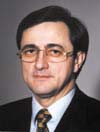 |
Gottfried Dutiné, Director of Alcatel/SEL Germany: 'When Telecom and Internet Converge' Gottfried Dutiné has a background in communications technology and received his PhD in that area from the University of Darmstadt. He joined Rockwell-Collins in 1979 where he moved up to the position of Director of Engineering. He then joined Motorola to become Group Director of Product Operations in the US, to be followed by several positions at subsidiaries of Robert Bosch GmbH. Currently he is chairman of the management board of Alcatel SEL AG, Area President Alcatel Central and Eastern Europe and Managing Director of Alcatel Germany. |
 |
Jacques-Louis Lions, Institut de France: 'The Future of Scientific Computation' Professor at the 'Collège de France' since 1973 and ex-President of the Academy of Science, Jacques-Louis Lions graduated from Ecole Normale Supérieure in 1947. A mathematician specialised in system control and analysis, his work focuses on computer science and digital processing applied, in particular, to aerospace, energy, production, information and the environment. He taught as a Professor in Nancy and Paris. He was President of INRIA from 1980 to 1984 before being nominated President of CNES from 1984 to 1992. Jacques-Louis Lions, high scientific and space consultant for Dassault-Aviation, is President of a number of Scientific Councils. He is a member of many foreign and international academies. Award winner at the Academy of Science, he has received many prizes including the Japan award and the Harvey prize from Technion, Haifa. |
ERCIM - a Virtual Laboratory for IT Research in Europe
|
Presentations:
|
Demonstrations 4 and 5 NovemberIn conjunction with the presentations on, demonstrations of current research was given: CYCAB - Self-service vehicles for the cities of tomorrow. This new public transportation system is based on a fleet of small electric vehicles specifically designed for zones with limited access to regular automobiles. CyCab is entirely under computer control and can be driven manually with a joystick, or can be driven automatically under various modes. It is being developed by INRIA with the assistance of EDF, RATP and Andruet S.A. PERSONA - Tools for Social Navigation: Within the PERSONA project, four systems have been designed and implemented to deal with the problem of navigation through information space. One is the Agneta & Frida system, two characters that sits below the web browser and comment, ironically, their contents as the user browses the web. Another is the Social Navigator, a developers' set of tools that allows adding various social navigation possibilities to net-based applications. A third is the on-line store, EFOL, which incorporates social navigation into the domain of shopping for food. Finally, the Navigational Instrument is a computer-based method for evaluating applications early on in the design process. W3C - The World Wide Web Consortium, W3C, an industry consortium of over 350 organisations, jointly run at the W3C hosts MIT (USA), INRIA (Europe) and Keio University (Asia), was created to enhance the interoperability and promote the evolution of the World Wide Web. To enhance the communication between W3C and the Web community, W3C-Leverage Action opened six European W3C national offices, all located at ERCIM member institutes (RAL, GMD, SICS, FORTH, CWI, CNR) as the first point of contact between the Consortium and local W3C members, and also the general public, with an ongoing responsibility to organise local events. Virtual Reality for Scientific Visualization - Scientific visualization is the use of computer graphics to create visual images that aid the understanding of complex, often massive, numerical representations of scientific concepts or results. Scientific insight into complex phenomena depends in part on our ability to develop meaningful three-dimensional displays. Virtual environments are interactive, head coupled computer displays that give the scientist the illusion of immersing into a virtual world. The goal of our research is to construct virtual worlds in the hope that the scientist can get a better understanding of the problem under study. In this demonstration, we will show three examples of scientific virtual worlds. These examples stem from: computational fluid dynamics, cell biology, and the exploration of large data repositories on the Internet. IMU - Integrated Publishing in Multimedia Networks - VTT, together with Finnish universities has developed a new type of publication system for TV-programs and newspaper articles. The integrated publication IMU includes features both from newspapers and TV. The publication is delivered using fast networks like bidirectional cable TV network. By combining the contents of databases from several newspaper houses and TV companies a continuously updated and personalized WWW-multimedia publication is created. The users read the publication from Internet on their PC with normal WWW-browsers. Information at ERCIM Technical Reference Digital Library (ETRDL) - a digital collection of the technical documentation produced by ERCIM scientists. The system enables the ERCIM scientists to make their research results immediately available world-wide and provides them with appropriate on-line facilities to access the technical documentation of others working in the same field. The intention is also to make the ERCIM digital collections available as testbeds for the validation of research in the DL domain. MUSIC LAB of CNUCE-CNR - The keywords characterising the activity of the Computer Music laboratory of CNUCE/CNR, Pisa, are man-ma-chine interaction and real time gesture control. The computer interacts with the artist to produce music in many different ways. In order to achieve this, a special language called Real-Time Concurrent Pascal Music has been implemented. Using this language, a musical perfor-mance can be defined in terms of many procedures running simultaneously and interacting with the composition program during execution. VEP - Visual Enabling for Precision Surgery - a computer-based three-dimensional (3D) image guidance system for neurosurgical operations, supported by an interventional magnetic resonance imaging (MRI) system. Interventional MRI systems can generate intraoperative MR images which give important feedback for the precise positioning of surgical devices. One specific intervention technique considered within this project is laser-induced interstitial thermotherapy (LITT) where an optical fiber is implanted within a brain tumor to be coagulated by laser energy. Technically the system will be realised as an augmented reality system combining various types of medical and synthetic images. The surgeon will experience the environment as a kind of interactive graphical 3D scene showing all relevant data for the intended intervention. THE SNAKE - a robot for difficult inspection tasks. Movements in areas that are difficult to reach require unconventional robots with usually complex kinematics. As an example of such an unconventional robot, a snake-like robot has been built by GMD's Biomimetic Autonomous Robots team. The goal of this development is to imitate the movement of a biological snake as closely as possible. The movement of a real snake is very flexible as it can be adapted to various environments. Snakes are able to move on rough surfaces, they cross obstacles, and they can creep into areas that are very difficult to reach with any other kind of movement. This means that a snake-like robot with such properties would be an ideal inspection system (e.g. for tight tubes). The AVANTI Web Browser: The AVANTI web browser has been developed in the framework of the AVANTI project that aimed to address the interaction requirements of disabled individuals using Web-based multimedia applications and services. The resulting unified interface of the browser is a single artefact, in which adaptability and adaptivity techniques are employed, in order to meet the requirements of potentially all users. In the demonstration version, three user categories are supported: able bodied, blind and motor impaired. DialWeb - The Internet is increasingly used for distributing information and services via the World Wide Web. While information on the Internet today is typically presented via graphical browsers on fixed computers with large screens, telephony, especially mobile telephony, potentially offers more ubiquitous access via a new generation of browsers, including micro graphical browsers and voice browsers. The DialWeb project implements an information service (a music and concert event guide) which can be accessed through a telephone-based voice browser as well as through a conventional graphical browser. The project aims to develop guidelines for designing web services with multiple media interfaces, by evaluating how users interact with the concert guide service. A real-time, intelligent advisory system - A new SCADA system was introduced in the 120/400kV Substation of the Paks Nuclear Power Plant. A real-time, intelligent advisory system was developed and embedded into the SCADA system to increase the reliability and safety of energy supply. The main functions of the system help in maintenance design, in management of alarm situations, in fast analysis of malfunctions and in fast recovery, in designing switching sequences, etc. These functions assist the operator in faster and more effective reactions, supports the management and the plant engineers to better understand and evaluate the whole system, and to improve planning. MPEG7: More and more audio-visual information is available in digital form, in various places around the world. Along with the information, people appear that want to use it. Before one can use any information, however, it will have to be located first. At the same time, the increasing availability of potentially interesting material makes this search harder. The question of finding content is not restricted to database retrieval applications; also in other areas similar questions exist. For instance, there is an increasing amount of (digital) broadcast channels available, and this makes it harder to select the broadcast channel (radio or TV) that is potentially interesting. In October 1996, MPEG (Moving Picture Experts Group) started a new work item to provide a solution for the urging problem of generally recognised descriptions for audio-visual content, which extend the limited capabilities of proprietary solutions in identifying content that exist today. The new member of the MPEG family is called "Multimedia Content Description Interface", or in short MPEG-7. |
